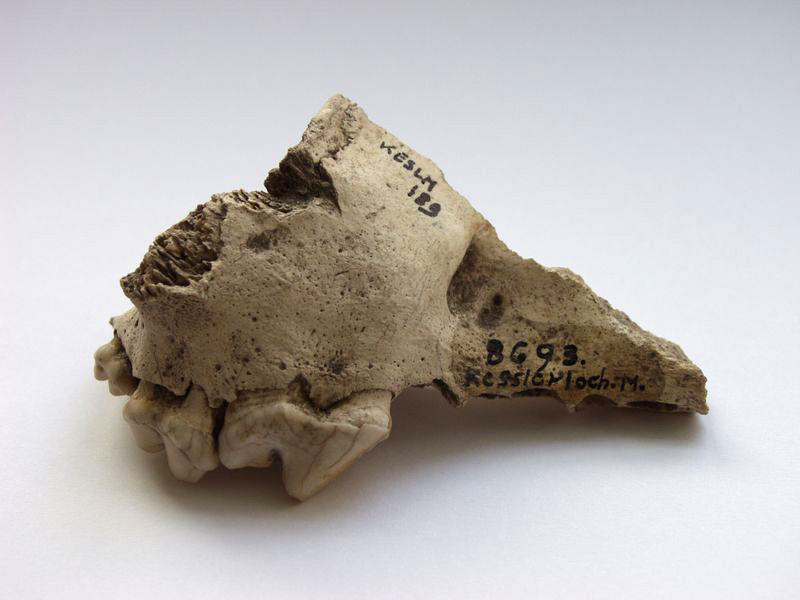
Could the world’s oldest dog be Swiss?

A cranial fossil found more than 100 years ago in a cave near the northern Swiss city of Schaffhausen may well belong to the oldest domestic dog in the world.
Researchers from Germany have clearly dated the find at the Kesslerloch cave to between 14,100 and 14,600 years ago.
The cranial fragment and teeth of the dog were found after investigations that began in the cave in 1873 but have only been analysed in recent years by researchers at Tübingen University.
The find has now been given recognition in the International Journal of Osteoarchaeology.
Zoological archaeologist Hannes Napierala could not help but laugh when he explained how he came across the dog.
“I found it rather unromantically in a box,” Napierala told swissinfo.ch.
“The excavations were [made] more than 100 years ago and the finds were stored in Schaffhausen all this time. Then during a project in the 1990s the material was borrowed by Tübingen and it was my job to look at the material, reanalyse it and write a report.”
Research in the 1870s did not prove very successful. “They didn’t realise it was a dog because the science of archaeology was not so advanced then. And they didn’t even think that stone-age people already had dogs.”
Hunters and gatherers
At that time humans were hunters and gatherers, Napierala explained.
He describes the find as “another piece in the puzzle towards understanding the whole late ice age and how people used to live”.
“It really tells us that 14,000 years before today, dogs were clearly very well domesticated.”
For Napierala and colleague Hans-Peter Uerpmann, the find is the oldest trace of the existence of man’s best friend. Their claim is supported by the fact that the premolars are clearly smaller than those of present-day wolves or wolf remains found at the Kesslerloch. Dogs are a domesticated form of the wolf.
“There are several other finds that are being discussed as possible evidence of earlier dog remains. The problem is that they are debatable… in the sense that they don’t really show us a clear difference from wolves, so they might [actually] be wolves.”
Wolf fossils
The researchers have analysed wolf fossils dating back 40,000 years ago as well as modern wolves in several collections.
What they found was that the size of the wolf over a span of 40,000 years has been quite stable and that the dog from the Kesslerloch was “clearly below that size”.
The next step now will be to try to extract ancient DNA from this find.
“We want to compare it genetically to the wolves from the site to see if this dog is related closely to the wolves of the region so that we can find out if it derives from a local wolf population.”
“Then we’ll try to compare it in a wider context with other possible wolves of the late ice age; we want to see where these dogs come from,” Napierala said.
It’s tempting to say that the find is not really news in 2010. After all, it was discovered in the 1870s and was the subject of Naperiala’s master’s thesis in 2008.
Napierala is philosophical about that. “No one reads masters’ theses, it wasn’t picked up by the media then, nor was it recognised internationally.”
Robert Brookes, swissinfo.ch
The dog was the only domestic animal to accompany late ice age hunters, some thousand years before the domestication of sheep, goats, aurochs and pigs.
In contrast to these animals, the dog was not kept primarily for economic reasons and it remained the only domestic carnivore before the cat joined humans at a much later time.
But when and where wild wolves first became domestic dogs still cannot be exactly pinpointed in space and time.
This is partly because the wolf occurs almost everywhere in the entire northern hemisphere and so may have become domesticated in a wide area.
The Kesslerloch cave is in the northern part of Switzerland, only a few kilometres from the German border.
It lies in the limestone of the Upper Jurassic that stretches from the Swabian Alb to the French Jura.
The valley to which the cave opens belongs to the Rhine drainage system of ice age alpine glaciers. Shortly after deglaciation of the area, Kesslerloch was occupied by Magdalenian hunters and gatherers (around 17,000 to 9,000 years ago).
The first archaeological investigations at the Kesslerloch were made in 1873 by Konrad Merk.
Swiss paleontologist Ludwig Rütimeyer published a first report on the faunal remains of the Kesslerloch in 1875.
According to the Schaffhausen cantonal archaeologist, Markus Höneisen, the Kesslerloch site is far from giving up all its secrets. But his department has enough to cope with at present with finds elsewhere that are threatened by real estate plans.

In compliance with the JTI standards
More: SWI swissinfo.ch certified by the Journalism Trust Initiative





























You can find an overview of ongoing debates with our journalists here . Please join us!
If you want to start a conversation about a topic raised in this article or want to report factual errors, email us at english@swissinfo.ch.